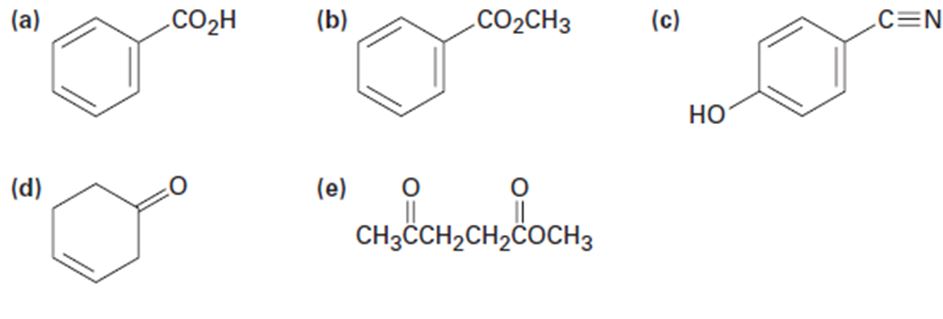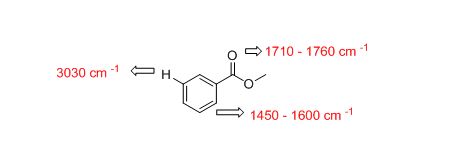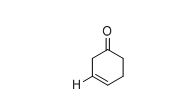
Concept explainers
At what approximate positions might the following compounds show IR absorptions?

a)
Interpretation:
The approximate absorption frequency has to be given for compound.
Concept introduction:
Spectroscopy: It is study of the interaction of matter and electromagnetic radiation, a continuum of different types of electromagnetic radiation each associated with a particular energy range makes up the electromagnetic spectrum.
IR frequency (cm-1): It is the number of wave crests that pass by a given point in one second frequency has units of hertz (Hz).
Stretch vibrations: It is a vibration occurring along the line of the bond a stretching vibration changes the bond length.
Bending vibrations: It is a vibration that does not occur along the line of the bond, bending vibration changes the bond angle.
Answer to Problem 33AP
The IR absorptions values at 1450-1600 cm-1 is for carbon double bond carbon stretching frequency, 3030 cm-1 is for aromatic carbon hydrogen stretching frequency, 1710-1760 cm-1 is for acid carbonyl frequency and 2500-3100 cm-1 is for acid hydroxyl frequency.
Explanation of Solution
Given information:
The approximate absorption frequency for the given compound,

The IR absorptions values at 1450-1600 cm-1 is for carbon double bond carbon stretching frequency, 3030 cm-1 is for aromatic carbon hydrogen stretching frequency, 1710-1760 cm-1 is for acid carbonyl frequency and 2500-3100 cm-1 is for acid hydroxyl frequency.
Therefore, the approximate absorption frequency for the given compound is shown below,

The approximate absorption frequency is given for compound.
b)
Interpretation:
The approximate absorption frequency has to be given for compound.
Concept introduction:
Spectroscopy: It is study of the interaction of matter and electromagnetic radiation, a continuum of different types of electromagnetic radiation each associated with a particular energy range makes up the electromagnetic spectrum.
IR frequency (cm-1): It is the number of wave crests that pass by a given point in one second frequency has units of hertz (Hz).
Stretch vibrations: It is a vibration occurring along the line of the bond a stretching vibration changes the bond length.
Bending vibrations: It is a vibration that does not occur along the line of the bond, bending vibration changes the bond angle.
Answer to Problem 33AP
The IR absorptions values at 1450-1600 cm-1 is for carbon double bond carbon stretching frequency, 3030 cm-1 is for aromatic carbon hydrogen stretching frequency, 1710-1760 cm-1 is for acid carbonyl frequency and 2500-3100 cm-1 is for acid hydroxyl frequency.
Explanation of Solution
Given information:
The approximate absorption frequency for the given compound,

The IR absorptions values at 1450-1600 cm-1 is for carbon double bond carbon stretching frequency, 3030 cm-1 is for aromatic carbon hydrogen stretching frequency, 1710-1760 cm-1 is for acid carbonyl frequency and 2500-3100 cm-1 is for acid hydroxyl frequency.
Therefore, the approximate absorption frequency for the given compound is shown below,

The difference between given pairs of isomers is explained by using infrared spectroscopy.
c)
Interpretation:
The difference between given pairs of isomer has to be explained by using infrared spectroscopy.
Concept introduction:
Spectroscopy: It is study of the interaction of matter and electromagnetic radiation, a continuum of different types of electromagnetic radiation each associated with a particular energy range makes up the electromagnetic spectrum.
IR frequency (cm-1): It is the number of wave crests that pass by a given point in one second frequency has units of hertz (Hz).
Stretch vibrations: It is a vibration occurring along the line of the bond a stretching vibration changes the bond length.
Bending vibrations: It is a vibration that does not occur along the line of the bond, bending vibration changes the bond angle.
Answer to Problem 33AP
The IR absorptions values at 1450-1600 cm-1 is for carbon double bond carbon stretching frequency, 3030 cm-1 is for aromatic carbon hydrogen stretching frequency, 2210-2260 cm-1 is for acid carbonyl frequency and 3400-3650 cm-1 is for acid hydroxyl frequency.
Explanation of Solution
Given information:
The approximate absorption frequency for the given compound,

The IR absorptions values at 1450-1600 cm-1 is for carbon double bond carbon stretching frequency, 3030 cm-1 is for aromatic carbon hydrogen stretching frequency, 2210-2260 cm-1 is for acid carbonyl frequency and 3400-3650 cm-1 is for acid hydroxyl frequency.
Therefore, the approximate absorption frequency for the given compound is shown below,

The difference between given pairs of isomers is explained by using infrared spectroscopy.
d)
Interpretation:
The difference between given pairs of isomer has to be explained by using infrared spectroscopy.
Concept introduction:
Spectroscopy: It is study of the interaction of matter and electromagnetic radiation, a continuum of different types of electromagnetic radiation each associated with a particular energy range makes up the electromagnetic spectrum.
IR frequency (cm-1): It is the number of wave crests that pass by a given point in one second frequency has units of hertz (Hz).
Stretch vibrations: It is a vibration occurring along the line of the bond a stretching vibration changes the bond length.
Bending vibrations: It is a vibration that does not occur along the line of the bond, bending vibration changes the bond angle.
Answer to Problem 33AP
The IR absorptions values at 1640-1680 cm-1 is for carbon double bond carbon stretching frequency, 3020-3100 cm-1 is for vinylic carbon hydrogen stretching frequency and 1715 cm-1 is for acid hydroxyl frequency.
Explanation of Solution
Given information:
The approximate absorption frequency for the given compound,

The IR absorptions values at 1640-1680 cm-1 is for carbon double bond carbon stretching frequency, 3020-3100 cm-1 is for vinylic carbon hydrogen stretching frequency and 1715 cm-1 is for acid hydroxyl frequency.
Therefore, the approximate absorption frequency for the given compound is shown below,

The difference between given pairs of isomers is explained by using infrared spectroscopy.
e)
Interpretation:
The difference between given pairs of isomer has to be explained by using infrared spectroscopy.
Concept introduction:
Spectroscopy: It is study of the interaction of matter and electromagnetic radiation, a continuum of different types of electromagnetic radiation each associated with a particular energy range makes up the electromagnetic spectrum.
IR frequency (cm-1): It is the number of wave crests that pass by a given point in one second frequency has units of hertz (Hz).
Stretch vibrations: It is a vibration occurring along the line of the bond a stretching vibration changes the bond length.
Bending vibrations: It is a vibration that does not occur along the line of the bond, bending vibration changes the bond angle.
Answer to Problem 33AP
The IR absorptions values at 1715 cm-1 is for carbonyl (ketone) stretching frequency and 1735 cm-1 is for carbonyl ester frequency.
Explanation of Solution
Given information:
The approximate absorption frequency for the given compound,

The IR absorptions values at 1715 cm-1 is for carbonyl (ketone) stretching frequency and 1735 cm-1 is for carbonyl ester frequency.
Therefore, the approximate absorption frequency for the given compound is shown below,

The difference between given pairs of isomers is explained by using infrared spectroscopy.
Want to see more full solutions like this?
Chapter 12 Solutions
Study Guide with Student Solutions Manual for McMurry's Organic Chemistry, 9th
- please explain this in simple termsarrow_forwardK Most Reactive Na (3 pts) Can the metal activity series (shown on the right) or a standard reduction potential table explain why potassium metal can be prepared from the reaction of molten KCI and Na metal but sodium metal is not prepared from the reaction of molten NaCl and K metal? Show how (not). Ca Mg Al с Zn Fe Sn Pb H Cu Ag Au Least Reactivearrow_forward(2 pts) Why is O2 more stable as a diatomic molecule than S2?arrow_forward
- Draw the Lewis structure for the polyatomic phosphite (PO¾³¯) a anion. Be sure to include all resonance structures that satisfy the octet rule. C I A [ ]¯arrow_forwardDecide whether these proposed Lewis structures are reasonable. proposed Lewis structure Is the proposed Lewis structure reasonable? Yes. :0: Cl C C1: 0=0: : 0 : : 0 : H C N No, it has the wrong number of valence electrons. The correct number is: ☐ No, it has the right number of valence electrons but doesn't satisfy the octet rule. The symbols of the problem atoms are:* ☐ Yes. No, it has the wrong number of valence electrons. The correct number is: ☐ No, it has the right number of valence electrons but doesn't satisfy the octet rule. The symbols of the problem atoms are:* Yes. ☐ No, it has the wrong number of valence electrons. The correct number is: ☐ No, it has the right number of valence electrons but doesn't satisfy the octet rule. The symbols of the problem atoms are:* | * If two or more atoms of the same element don't satisfy the octet rule, just enter the chemical symbol as many times as necessary. For example, if two oxygen atoms don't satisfy the octet rule, enter "0,0".arrow_forwardDraw the Lewis structure for the polyatomic trisulfide anion. Be sure to include all resonance structures that satisfy the octet rule. с [ ] - Garrow_forward
- 1. Calculate the accurate monoisotopic mass (using all 1H, 12C, 14N, 160 and 35CI) for your product using the table in your lab manual. Don't include the Cl, since you should only have [M+H]*. Compare this to the value you see on the LC-MS printout. How much different are they? 2. There are four isotopic peaks for the [M+H]* ion at m/z 240, 241, 242 and 243. For one point of extra credit, explain what each of these is and why they are present. 3. There is a fragment ion at m/z 184. For one point of extra credit, identify this fragment and confirm by calculating the accurate monoisotopic mass. 4. The UV spectrum is also at the bottom of your printout. For one point of extra credit, look up the UV spectrum of bupropion on Google Images and compare to your spectrum. Do they match? Cite your source. 5. For most of you, there will be a second chromatographic peak whose m/z is 74 (to a round number). For one point of extra credit, see if you can identify this molecule as well and confirm by…arrow_forwardPlease draw, not just describe!arrow_forwardcan you draw each step on a piece of a paper please this is very confusing to mearrow_forward
- > Can the molecule on the right-hand side of this organic reaction be made in good yield from no more than two reactants, in one step, by moderately heating the reactants? esc ? A O O •If your answer is yes, then draw the reactant or reactants in the drawing area below. You can draw the reactants in any arrangement you like. • If your answer is no, check the box under the drawing area instead. olo 18 Ar Explanation Check BB Click and drag to start drawing a structure. 2025 McGraw Hill LLC. All Rights Reserved. Terms of Use | Privacy Center Accessibilityarrow_forwardName the structurearrow_forward> For each pair of substrates below, choose the one that will react faster in a substitution reaction, assuming that: 1. the rate of substitution doesn't depend on nucleophile concentration and 2. the products are a roughly 50/50 mixture of enantiomers. Substrate A Substrate B Faster Rate X CI (Choose one) (Choose one) CI Br Explanation Check Br (Choose one) C 2025 McGraw Hill LLC. All Rights Reserved. Terms of Use | Privacy A F10arrow_forward

 Organic Chemistry: A Guided InquiryChemistryISBN:9780618974122Author:Andrei StraumanisPublisher:Cengage Learning
Organic Chemistry: A Guided InquiryChemistryISBN:9780618974122Author:Andrei StraumanisPublisher:Cengage Learning Organic ChemistryChemistryISBN:9781305580350Author:William H. Brown, Brent L. Iverson, Eric Anslyn, Christopher S. FootePublisher:Cengage Learning
Organic ChemistryChemistryISBN:9781305580350Author:William H. Brown, Brent L. Iverson, Eric Anslyn, Christopher S. FootePublisher:Cengage Learning


